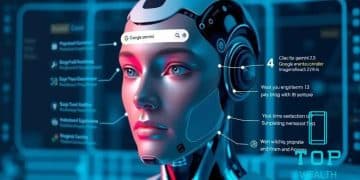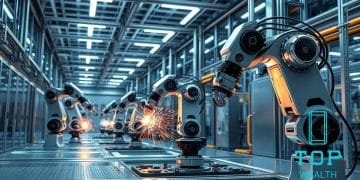GPT-5 promises breakthrough in natural language tasks

GPT-5 promises breakthrough in natural language tasks by enhancing communication, enabling automation, and providing valuable insights, all while addressing ethical concerns and the need for workforce adaptation.
GPT-5 promises to revolutionize natural language tasks, raising exciting possibilities for enhancing communication. Have you ever wondered how such advancements might affect our daily interactions and work processes?
Understanding the advancements of GPT-5
Understanding the advancements of GPT-5 is crucial for grasping how this technology changes our interaction with machines. This new version improves not just in performance, but also in understanding context and generating coherent text.
One major advancement is its ability to learn from vast amounts of data. With better training methods, GPT-5 achieves a higher level of accuracy. Now, let’s look deeper into some of its key features.
Key advancements in GPT-5
Unlike previous versions, GPT-5 showcases remarkable enhancements in areas like:
- Contextual understanding: It can grasp nuances and contextual cues more effectively.
- Conversational depth: Conversations feel more natural, creating better user experiences.
- Broader knowledge base: GPT-5 pulls information from more diverse sources, enriching its responses.
As it evolves, GPT-5 leverages advanced machine learning techniques. These improvements allow it to adapt to various writing styles and tones. Whether you need a formal report or a casual chat, GPT-5 can adjust seamlessly.
The balance between creativity and factual accuracy is another standout feature. GPT-5 can generate imaginative content without straying too far from proven facts. This balance fosters trust and reliability in responses.
Real-world applications
The implications of these advancements span across different sectors. In education, GPT-5 can assist teachers by providing tailored lesson plans. In customer service, it enhances response times and accuracy, leading to improved customer satisfaction.
Such versatility means that businesses are eager to adopt this technology. As industries embrace GPT-5, the demand for skilled users capable of leveraging its capabilities increases.
Understanding these advancements prepares us for future challenges and opportunities with AI. As we look ahead, it’s clear that GPT-5 stands at the forefront of revolutionizing how we process and generate language.
Key features that set GPT-5 apart

Key features that set GPT-5 apart from previous models highlight its advanced capabilities. It distinguishes itself with improved accuracy and a deeper understanding of context. These features allow it to generate text that feels more human-like.
Performance is a major aspect where GPT-5 excels. It utilizes a larger dataset for training, resulting in richer and more context-aware responses. This leads to high-quality content generation tailored to user needs.
Advanced Learning Algorithms
The learning algorithms in GPT-5 are significantly upgraded. They enable the model to adapt more quickly to various subjects and maintain coherence throughout long passages. This includes:
- Dynamic adaptability: Changes based on real-time feedback, improving accuracy.
- Context retention: Better memory of previous parts of the conversation.
- Multi-turn conversation capability: Engages in prolonged discussions without losing track.
These adaptations make GPT-5 suitable for a variety of applications. In fields like marketing, it can craft persuasive copy. In education, it serves as a tutor, enhancing learning outcomes.
The user interface has also seen improvements. Interactions feel smoother, as GPT-5 offers a more natural flow in conversations. Users can expect a seamless experience while engaging with the AI.
Enhanced Creativity
An exciting aspect of GPT-5 is its increased creative capabilities. It generates ideas and engages in storytelling with a newfound flair. This feature can be valuable for writers looking for inspiration or businesses in need of innovative solutions.
With these advanced capabilities, GPT-5 sets a high standard for future AI developments. It embodies a significant leap towards achieving human-like understanding and interaction in technology.
Applications of GPT-5 in various fields
Applications of GPT-5 in various fields showcase its versatility and impact on multiple industries. With its advanced language processing capabilities, GPT-5 is transforming how organizations operate.
One major area of application is in customer service. Companies are using GPT-5 to create smart chatbots. These chatbots can understand and respond to customer queries in real-time.
In Healthcare
In the healthcare sector, GPT-5 aids in managing patient interactions. It can assist in scheduling appointments and providing information about symptoms. This leads to better patient experience and efficiency in healthcare services.
- Patient Education: GPT-5 generates tailored content for patients to understand their conditions.
- Data Analysis: It analyzes patient data to suggest personalized treatment options.
- Telemedicine: Enhances communication during virtual consultations.
Another exciting field is education. GPT-5 acts as a personal tutor, offering customized learning experiences. It can clarify difficult concepts and even help with homework.
In Marketing
Marketing teams are leveraging GPT-5 to create engaging campaigns. The AI generates creative content that resonates with diverse audiences. This results in higher conversion rates.
Its ability to analyze market trends allows businesses to stay ahead of competition. By providing insights, GPT-5 helps brands refine their strategies effectively.
Moreover, in content creation, writers find GPT-5 to be an invaluable tool. It stimulates creativity by suggesting new ideas and generating outlines. This collaboration leads to quicker content development and improved quality.
Overall, the applications of GPT-5 are wide-ranging and impactful. As it becomes more integrated into various sectors, it promises to enhance productivity and foster innovation.
Challenges associated with GPT-5 deployment
Challenges associated with GPT-5 deployment are important to understand as this technology becomes more widespread. While GPT-5 offers many benefits, several challenges must be addressed to ensure successful integration.
One significant issue is the need for accurate and diverse data. The quality of the input data directly influences the performance of GPT-5. If the data is biased or not representative, it can lead to skewed results. This necessitates thorough data curation.
Ethical Considerations
The deployment of GPT-5 raises various ethical questions. How do we ensure that AI does not perpetuate bias? This is a crucial concern for developers. They must implement strict guidelines to monitor and correct biased outputs.
- Content Moderation: Continuous monitoring to filter out harmful content generated by the AI.
- User Privacy: Safeguarding user data during interactions with the AI.
- Transparency: Being open about how the AI works and how data is used.
Another challenge is the need for technical expertise. Organizations may struggle to find qualified personnel who understand how to implement and maintain GPT-5. Investing in training and education for staff can be crucial for successful adoption.
Operational Costs
Deploying GPT-5 can also involve significant operational costs. This includes expenses for cloud services, infrastructure, and ongoing maintenance. Companies must be prepared for these investments to maximize the benefits of the AI.
Finally, as users interact with GPT-5, ensuring a positive experience is vital. Feedback loops can help improve its interactions. Organizations need to establish systems for collecting and acting on user feedback to enhance the model continuously.
Despite these challenges, addressing them effectively can lead to increased adoption and better outcomes in various applications. Understanding these barriers is key to harnessing the full potential of GPT-5.
Future implications of GPT-5 technology
Future implications of GPT-5 technology are vast and potentially transformative. As we continue to integrate this technology into everyday life, we can expect numerous advancements across various sectors.
One of the most significant implications is the enhanced communication between humans and machines. GPT-5’s improved understanding of context and nuance will allow for more intuitive interactions. This can lead to better customer experiences in service industries.
Advancements in Automation
The rise of GPT-5 may also accelerate automation in numerous fields. By taking over repetitive tasks, it can free up employees to focus on more creative and strategic work. For example, in content creation, GPT-5 can draft articles, allowing writers to refine and polish the text.
- In finance: GPT-5 can analyze market trends, providing insights for investment strategies.
- In healthcare: It can assist in diagnosing conditions, suggesting treatments based on extensive data analysis.
- In education: Personalized learning experiences tailored to each student’s needs will be possible.
Moreover, GPT-5’s ability to analyze large datasets will enhance decision-making processes. Businesses will be able to make data-driven choices, leading to greater efficiency and effectiveness.
Ethical and Social Considerations
However, as we embrace these advancements, we must also consider the ethical implications. The potential misuse of AI technology raises concerns about privacy and security. Ensuring that GPT-5 is used responsibly will be crucial for its acceptance.
Societal impacts will also be significant. As jobs evolve with AI integration, there will be a need for extensive retraining of the workforce. Emphasizing skills that complement AI technology will become essential in education and professional development.
In summary, while the future implications of GPT-5 technology are promising, they require careful consideration to maximize benefits while minimizing risks. Embracing these changes will shape a more advanced digital landscape.
FAQ – Frequently Asked Questions about GPT-5 Technology
What are the main advantages of GPT-5 technology?
GPT-5 enhances communication, improves automation, and provides valuable insights from data analysis.
How can GPT-5 be used in customer service?
GPT-5 can create intelligent chatbots that respond to customer inquiries in real-time, enhancing user experiences.
What ethical concerns surround the deployment of GPT-5?
Concerns include data privacy, potential bias in AI outputs, and the responsibility of companies to use AI ethically.
How will GPT-5 impact the workforce?
GPT-5 will likely lead to job evolution, requiring workforce retraining to adapt to new roles that complement AI technology.





